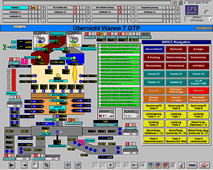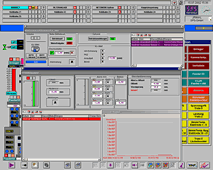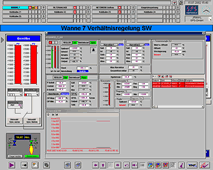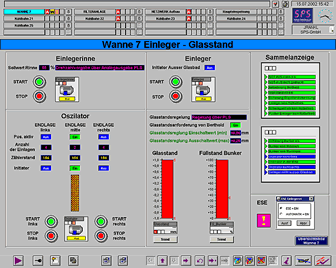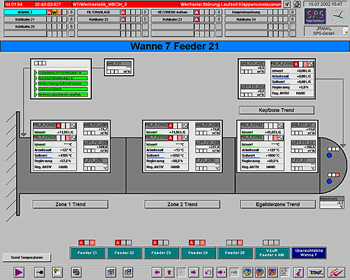Plant automation with faceplate technology
Based on the process control system Simatic PCS7, the new software packages from Schlemmer Prozess Systeme GmbH provide a universal and standardized solution for the entire plant automation. Not only melting units, lehr belts, batch plants and production lines, but also subsidiary facilities such as low-voltage distribution, compressor control, water treatment and cullet recycling, etc., are managed by the same hardware and software.
During the new construction of the tank furnace of Heinz Glas in Piesau, a new visualization system based on this technology has being installed. The tank has already been equipped with a process control system including process visualization and hardware controllers, but for economic reasons, this system was replaced with a new PCS7 process control system.
For the short term, an upgrade of the existing automation installations with new feeders and lehr belts might have offered a cheaper solution, but after a careful auditing with emphasis on properties such as consistency, future reliability, plant availability, easy maintenance, upgrading options, spare part management, staff training and service etc., it became obvious that a change to our new concept would pay off very quickly.
What is the great advantage of faceplates?
Faceplates offer the following features:
- All unit-related malfunctions are indicated in plain text
- Operator reports
- Each alarm can be turned on or off separately
- Alarm adjustments
- Standardization of measurement
- Graphic display and adjustments
- Operating mode selection
- Status display
- Input of parameter
Four authorization levels are assigned to each faceplate:
| Process operation | permits adjustment of set point and graduation | |
| Advanced Process operation | permits adjustment of alarm limits | |
| Controller configuration | permits adjustment of PID parameters | |
| Alarm management | permits locking or enabling alarms |
Each analog value is assigned to a faceplate and to a graphic representation (not a mere online graph), which is stored in the process record archive. This ensures a constant overall view of the plant. All faceplate-related reports are displayed on screen. Object-specific alarms can be answered directly on the faceplate. Apart from the change towards faceplate technology, several improvements have been introduced. For instance, the controller algorithm for power controlling was optimized for minimum switch frequency of the slide transformer. Now, power adjustment can be achieved by a single set command, providing an accuracy of 5 kW. This means that, for example, power alteration from 200 kW to 250 kW is achieved within minimum motor actuating time by a single `up-impulse´.
Charger controlling
The newly designed charger offers an accuracy of about +/- 0,5 mm. Charging can be adjusted by position and duration, according to tank load.
For quick and easy compensation of bead weight fluctuations and load changes, the feeder control package developed by SPS was applied. This software package allows automatic increases and decreases in the feeder temperature profile. Each zone can be set individually, and the machine operator merely has to adjust one temperature setting for the whole feeder. In addition, appropriate bead weight determination and long-term correction allow automatic feeder adjustment.
All analog values and control circuits display their respective trends within the faceplate. Moreover, master diagrammes (e.g., one trend including all values per zone, or all temperatures per feeder) have been designed to permit quick and comprehensible analysis.
Siemens PCS7 plus faceplate software – an economical and convenient solution for automating the glass industry’s particular demands
When operating a melter or several furnaces, Siemens PCS7 offers the perfect tool for
- fast reaction of the operator in case of interferences during production
- a standardized design of the whole plant
- the option to upgrade independent from a single supplier
- adjustments carried out by own personnel


